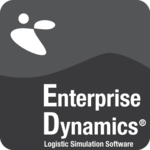Description

Enterprise Dynamics

Simile
Comprehensive Overview: Enterprise Dynamics vs Simile
Enterprise Dynamics and Simile are two distinct simulation software products used for a variety of modeling purposes. They cater to different needs and markets within the field of simulation and modeling.
a) Primary Functions and Target Markets
Enterprise Dynamics:
-
Primary Functions:
- Enterprise Dynamics is a sophisticated discrete event simulation software primarily used for modeling, analyzing, visualizing, and optimizing complex systems and processes. Its capabilities are geared towards logistical and operational processes, such as supply chain management, production logistics, and manufacturing systems.
- The software allows users to create detailed simulations of intricate processes, enabling the assessment and improvement of system performance. It includes features for 3D visualization, statistical analysis, and decision support among others.
-
Target Markets:
- It is widely used in industries such as manufacturing, logistics, transportation, healthcare, and distribution. Organizations looking to optimize resource utilization, improve process efficiency, and reduce operational costs often use Enterprise Dynamics.
Simile:
-
Primary Functions:
- Simile is a software tool focused on system dynamics and agent-based modeling. Its primary use is for modeling ecological, environmental, and biological systems, as well as other systems where the interaction between components is pivotal.
- It provides a graphical user interface to create models using a visual approach. Its strengths lie in its flexibility to combine diverse modeling paradigms, which is ideal for multi-disciplinary research and teaching.
-
Target Markets:
- Simile is often used in academic, research, and governmental institutions. It caters to users involved in ecological and environmental modeling, like landscape ecology, conservation planning, and sustainable development, as well as those in social sciences that require a systemic approach to problems.
b) Market Share and User Base
-
Enterprise Dynamics:
- Due to its strong focus on discrete event simulation for operational and logistical processes, Enterprise Dynamics traditionally holds a steady presence in industrial sectors. Its user base includes enterprises looking for robust optimization solutions, but specific market share figures are not typically disclosed publicly.
- The software is acknowledged among specialists in operations research and logistics management; hence, its user base is professional and industry-focused.
-
Simile:
- Simile serves a more niche market that is more academically and research-oriented. It is well-regarded in specific niches like ecological modeling, but it has a smaller commercial user base compared to tools focused on industrial logistics like Enterprise Dynamics.
- Its market penetration is more prominent in academic and research institutions than in corporate environments.
c) Key Differentiating Factors
-
Complexity and Focus:
- Enterprise Dynamics is focused on discrete event simulation, providing detailed analysis tools for industrial applications. It's geared towards improving the efficiency of complex operational systems.
- Simile, on the other hand, emphasizes system dynamics and agent-based modeling. It suits users looking to simulate environmental and biological systems where component interactions are crucial.
-
User Interface and Capabilities:
- Enterprise Dynamics offers sophisticated 3D visualization capabilities which is beneficial for industries requiring detailed operational models. This makes it particularly appealing for logistics and manufacturing simulations.
- Simile’s strength lies in its intuitive graphical interface, which allows researchers to visually construct models, making it highly suitable for educational purposes and conceptual modeling.
-
Community and Support:
- Enterprise Dynamics is supported by a commercial organization, providing industry-level support, which can be crucial for its corporate users.
- Simile benefits from a community of researchers and educators, with a focus on collaborative improvement and academic use, offering support in more informal environments such as academic discussions and forums.
In summary, while both Enterprise Dynamics and Simile are valuable tools within their spheres, they serve different functions and markets: the former in industrial simulation and logistics optimization, and the latter in ecological and environmental research and education. Their differentiation lies in their technical capabilities and targeted industries or user communities.
Contact Info

Year founded :
1992
Not Available
Not Available
South Africa
http://www.linkedin.com/company/enterprise-dynamics

Year founded :
2019
Not Available
Not Available
United States
Not Available
Feature Similarity Breakdown: Enterprise Dynamics, Simile
Enterprise Dynamics and Simile are both modeling and simulation tools, but they cater to different niches within simulation. Here's a breakdown of their features and comparisons:
a) Core Features in Common
-
Modeling and Simulation Capabilities: Both tools offer robust environments for building and executing simulation models. They are designed to simulate complex systems and processes.
-
Discrete-Event Simulation: This is a common simulation method provided by both tools, allowing users to model the operation of a system as a discrete sequence of events.
-
Visualization Tools: Both platforms offer visualization features to help users better understand their models and simulations, often providing 2D or 3D visualizations.
-
Customizability: Both allow users to customize models using various parameters and inputs, accommodating different scenarios and experiments.
-
Data Import/Export: They support importing and exporting data necessary for building and analyzing simulations, usually through standard formats like CSV.
-
Report Generation: The ability to generate reports based on simulation results is a feature offered by both, assisting users in analyzing and presenting their findings.
b) User Interface Comparison
-
Enterprise Dynamics: The user interface of Enterprise Dynamics is typically more focused on industrial processes, providing a robust library of objects and customizable components targeted at logistics, manufacturing, and supply chain operations. It is designed to handle intricate process models with detailed visualizations and a wide array of analysis tools. The interface is relatively user-friendly, but it has a higher learning curve due to its extensive features tailored for complex systems.
-
Simile: Simile offers a more streamlined and straightforward user interface that is geared toward system dynamics and ecological modeling. It uses a visual programming approach, which can be more intuitive for users new to modeling. The focus on graphical representations of models and the use of simple drag-and-drop functionalities make it accessible for users who need to model ecosystems, environmental processes, or other continuous systems.
c) Unique Features
-
Enterprise Dynamics:
- 4D Script: A robust scripting language unique to Enterprise Dynamics that enhances the capability to customize and control simulation models to a high degree.
- Industry Libraries: Extensive libraries tailored for specific industries, such as manufacturing, logistics, and supply chain processes.
- Detailed 3D Animations: The ability to create highly detailed simulations with 3D animations offers an edge in visualizing complex industrial processes.
-
Simile:
- Systems Dynamics and Agent-Based Modeling: Unlike Enterprise Dynamics, Simile’s focus on combining both systems dynamics and agent-based modeling sets it apart for users looking at ecological or biological systems.
- Model Reusability: It emphasizes component-based modeling which allows for significant reusability and modular construction of models, making it particularly efficient for research and educational purposes.
- Interface with GIS: Simile has strong integrations with Geographical Information Systems (GIS), making it better suited for spatially explicit modeling.
In summary, while both Enterprise Dynamics and Simile share common features as simulation tools, they serve different audiences with distinct needs. Enterprise Dynamics is geared more toward industrial and logistics processes, whereas Simile is ideal for ecological and systems dynamics modeling. Their interfaces reflect these different focuses, and unique features further support their respective specializations.
Features

Analytics and Reporting
User Management
Data Integration
Support and Maintenance

Collaboration Tools
Security
Data Insights
User-Friendly Interface
Best Fit Use Cases: Enterprise Dynamics, Simile
Enterprise Dynamics and Simile are both simulation software tools, but they cater to different needs and industries. Let's explore their best-fit use cases and how they cater to different industry verticals or company sizes.
Enterprise Dynamics
a) Best Choice for Enterprise Dynamics:
Types of Businesses or Projects:
- Large-Scale Manufacturing and Logistics: Enterprise Dynamics is ideal for businesses in manufacturing and logistics that require detailed simulation of complex processes, such as production lines, supply chain logistics, and inventory management.
- Distribution Centers and Warehouses: Companies operating large distribution centers or warehouses can use Enterprise Dynamics to optimize their operations, including space utilization and material handling.
- Transport Systems Design: Organizations involved in designing or optimizing transport systems benefit from using Enterprise Dynamics to simulate vehicle flows, passenger logistics, and traffic management.
Scenarios and Features:
- Optimization of Processes: For projects that aim to reduce bottlenecks, improve process efficiency, and enhance resource utilization within large systems.
- Risk Analysis and Decision Support: Businesses looking to perform risk analysis and support decision-making in complex environments where multiple variables must be managed.
d) Industry Verticals and Company Sizes:
- Industry Verticals: Primarily used in manufacturing, logistics, transportation, and supply chain industries.
- Company Sizes: Larger enterprises with complex process simulation needs, generally medium to large-sized companies.
Simile
b) Preferred Option for Simile:
Types of Businesses or Projects:
- Environmental and Ecological Research: Simile is suited for projects involving modeling and simulation of environmental systems, agricultural processes, and ecological dynamics.
- Academic Research: Used extensively in academic research, where complex, system-level modeling is required to simulate biological, environmental, and ecological systems.
- Rural Development and Resource Management: Organizations focused on rural development or natural resource management benefit from Simile’s capabilities for simulating land use, water management, and ecosystem services.
Scenarios and Features:
- System Dynamics and Agent-Based Modeling: Preferred in scenarios that require combining system dynamics with agent-based approaches to simulate interactions within complex systems.
- Flexible Model Construction: Ideal for projects needing flexible, visually-oriented model construction that can handle diverse modeling paradigms.
d) Industry Verticals and Company Sizes:
- Industry Verticals: Predominantly used in environmental, agricultural, biological sciences, and educational sectors.
- Company Sizes: Suitable for academic institutions, research organizations, and smaller firms needing flexible, detailed modeling, typically small to medium-sized setups.
Conclusion
Both Enterprise Dynamics and Simile serve specific industry needs with differences in application focus. Enterprise Dynamics is better suited for large-scale, process-driven industries focusing on logistics and manufacturing, whereas Simile is geared towards environmental, biological, and ecological modeling, often used in research and academic scenarios. Their applicability varies significantly with industry focus and organizational needs, from large enterprises to specialized research institutions.
Pricing

Pricing Not Available

Pricing Not Available
Metrics History
Metrics History
Comparing undefined across companies
Conclusion & Final Verdict: Enterprise Dynamics vs Simile
To provide a conclusion and final verdict between Enterprise Dynamics and Simile, let's examine their features, pros and cons, and potential recommendations for users considering these simulation software tools.
a) Best Overall Value:
The best overall value between Enterprise Dynamics and Simile largely depends on the specific needs and use cases of the user. However, in a general sense, Enterprise Dynamics offers a more comprehensive and versatile set of features suited for complex, detailed, and dynamic simulations, which might be better suited for industrial and business process modeling. On the other hand, Simile might present better value for academic purposes or ecological simulations, given its emphasis on system dynamics and ecological modeling.
b) Pros and Cons:
Enterprise Dynamics:
-
Pros:
- Highly robust and flexible, capable of handling complex industrial simulations.
- Excellent for discrete-event simulation with extensive customization options.
- Strong visualization and reporting capabilities.
- Versatile and can be applied to a wide range of industries.
-
Cons:
- Steeper learning curve due to complexity.
- Higher cost which might not be suitable for smaller projects or limited budgets.
- Requires significant effort and expertise to fully leverage its capabilities.
Simile:
-
Pros:
- Intuitive interface with visual programming which is accessible to users with different levels of expertise.
- Well-suited for system dynamics and ecological modeling.
- Generally more affordable, which can be advantageous for small-scale or academic projects.
- Specific tools for network and agent-based modeling.
-
Cons:
- May not be as effective for highly complex industrial simulations.
- Less extensive in terms of features compared to Enterprise Dynamics.
- Might require additional integration for specific applications outside of its core strengths.
c) Recommendations for Users:
-
Define Your Simulation Needs: Users should clearly define the scope and nature of their simulation projects. If your project involves industrial processes or requires detailed discrete-event modeling, Enterprise Dynamics may be more appropriate. If your focus is on ecological models or you are working within an academic setting, Simile might be a better fit.
-
Consider Budget and Resources: Budget constraints and resource availability can be significant factors. Enterprises with substantial resources and a need for in-depth industrial modeling should lean towards Enterprise Dynamics. In contrast, cost-conscious users or those in academia might find Simile more cost-effective.
-
Evaluate Learning Curve and Usability: Assess the technical expertise available within your team. If ease of use and a lesser learning curve are priorities, Simile’s visual-oriented approach might be advantageous. Organizations with advanced analytical teams might not be hindered by Enterprise Dynamics' complexity.
-
Test Both Software: Consider trialing both software options, if possible. Running pilot projects can help evaluate which tool aligns best with your workflow and provided features.
In summary, if your primary consideration concerns complex, industry-oriented simulations with robust customization, Enterprise Dynamics would likely offer better value due to its comprehensive capabilities. For those engaged in system dynamics, ecological modeling, or seeking affordability and ease of use, Simile might provide the necessary balance of features and accessibility. Each product has its niche strengths, and the decision should align with your project’s specific requirements and constraints.
Add to compare
Add similar companies



